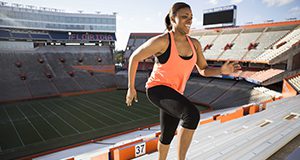
Being physically active is fun, has many physical and mental health benefits, and can help maintain a healthy weight. The Physical Activity Guidelines for Americans recommend that adults be purposefully active for at least 150 minutes per week for overall health and wellness. One proven strategy to make sure you reach your activity goal is to track your energy expenditure. This three-page fact sheet explains the different free and low cost cell phone apps, websites, and portable devices available for tracking physical activity. Written by Madison K. Keesling and Anne E. Mathews and published by the Food Science and Human Nutrition Department.
http://edis.ifas.ufl.edu/fs283
Tag: Physical Activity
Food and Fitness: Myths and Truths

Do you know how much water you should drink before exercise? Does loading up on carbs before a strenuous cardio workout improve performance? This 6-page fact sheet debunks some common myths about nutrition and fitness and offers other helpful advice for those who wish to stay active and eat a healthy diet. Written by Linda B. Bobroff and Amy Mullins, and published by the UF Department of Family, Youth and Community Sciences, June 2015.
http://edis.ifas.ufl.edu/fy470
Healthy Living: Beating Barriers to Physical Activity (FCS8818/FY883)
 Being active can help you function better and maintain your independence. It also can reduce your risk for getting some diseases, such as diabetes, and help you manage health problems you may already have. If you’re not active, what’s stopping you from getting started? Read on to learn how to overcome some common barriers! This 2-page fact sheet was written by Jennifer Hillan and Linda B. Bobroff, and published by the UF Department of Family Youth and Community Sciences, September 2012.
Being active can help you function better and maintain your independence. It also can reduce your risk for getting some diseases, such as diabetes, and help you manage health problems you may already have. If you’re not active, what’s stopping you from getting started? Read on to learn how to overcome some common barriers! This 2-page fact sheet was written by Jennifer Hillan and Linda B. Bobroff, and published by the UF Department of Family Youth and Community Sciences, September 2012.
http://edis.ifas.ufl.edu/fy883
Prevent Osteoporosis: Catch the Silent Thief (FCS8145/fy469)
 About 50 percent of women and 25 percent of men over age 50 will have a bone fracture caused by osteoporosis in their lifetimes. Many of these fractures, especially in the spine and hip, cause pain, disability, and loss of independence. About 24 percent of people aged 50 and over who have a hip fracture die in the year following the fracture. Learn more in this 8-page fact sheet written by Linda B. Bobroff and published by the UF Department of Family Youth and Community Sciences, March 2012.
About 50 percent of women and 25 percent of men over age 50 will have a bone fracture caused by osteoporosis in their lifetimes. Many of these fractures, especially in the spine and hip, cause pain, disability, and loss of independence. About 24 percent of people aged 50 and over who have a hip fracture die in the year following the fracture. Learn more in this 8-page fact sheet written by Linda B. Bobroff and published by the UF Department of Family Youth and Community Sciences, March 2012.
http://edis.ifas.ufl.edu/fy469
Criando niños saludables: Estado físico de la familia (FCS8892Span/FY1255)
 ¿Ser activo realmente hace una diferencia? ¡Sí! This 3-page fact sheet is the Spanish language version of Raising Healthy Children: Family Fitness. Written by Lisa D. Chan and Karla P. Shelnutt and published by the UF Department of Family Youth and Community Sciences, October 2011.
¿Ser activo realmente hace una diferencia? ¡Sí! This 3-page fact sheet is the Spanish language version of Raising Healthy Children: Family Fitness. Written by Lisa D. Chan and Karla P. Shelnutt and published by the UF Department of Family Youth and Community Sciences, October 2011.
http://edis.ifas.ufl.edu/fy1255
Living Actively for Good Health: Older Adults (FCS8753/FY554)
If you think physical activity is limited to strenuous activities like exercise classes and sports, think again! Read this 2-page fact sheet to learn why physical activity is important and how you can get started. Written by Jennifer Hillan and Anne Kendall and published by the UF Department of Family Youth and Community Sciences, October 2010.
http://edis.ifas.ufl.edu/fy554
FCS8853/HE778 Healthstyle: A Self-Test
Revised! FCS8853, a 6-page illustrated fact sheet adapted by Linda B. Bobroff, provides a brief self-test, developed by the Public Health Service, that indicates how well a person is doing in several categories of healthy behaviors recommended for most adult Americans. Published by the UF Department of Family Youth and Community Sciences, June 2010.
http://edis.ifas.ufl.edu/he778
FCS8922/FY1192 Raising Healthy Children: Active Families
FCS8922, a 5-page illustrated fact sheet by Jamie C. Stolarz and Karla P. Shelnutt, highlights the health benefits and recommendations for physical activity. It also includes tips for being active and suggestions of fun activities that the whole family can do together. Published by the UF Department of Family Youth and Community Sciences, June 2010.
http://edis.ifas.ufl.edu/fy1192